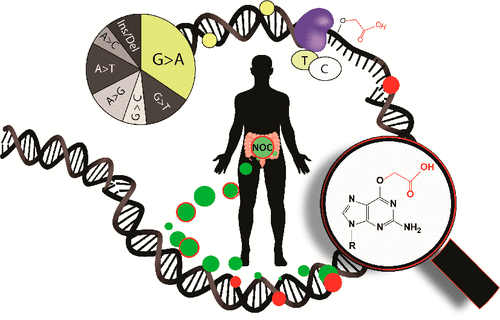当前位置:
X-MOL 学术
›
Chem. Res. Toxicol.
›
论文详情
Our official English website, www.x-mol.net, welcomes your
feedback! (Note: you will need to create a separate account there.)
A Chemical Link between Meat Consumption and Colorectal Cancer Development?
Chemical Research in Toxicology ( IF 3.7 ) Pub Date : 2021-01-08 , DOI: 10.1021/acs.chemrestox.0c00395 Claudia M N Aloisi 1 , Emma S Sandell 1 , Shana J Sturla 1
Chemical Research in Toxicology ( IF 3.7 ) Pub Date : 2021-01-08 , DOI: 10.1021/acs.chemrestox.0c00395 Claudia M N Aloisi 1 , Emma S Sandell 1 , Shana J Sturla 1
Affiliation

|
O6-carboxymethylguanine (O6-CMG) is a mutagenic DNA adduct that forms at increased levels when people eat meat. It has been studied as a potential initiating event in colorectal carcinogenesis. It can arise from alkylation of guanine in DNA by electrophilic degradation products of N-nitroso compounds. There is significant data regarding biochemical and cellular process, including DNA repair and translesion DNA synthesis that control O6-CMG accumulation, persistence, and mutagenicity. Mutation spectra arising from the adduct closely resemble common mutations in colorectal cancer; however, gaps remain in understanding the biochemical processes that regulate how and where the damage persists in the genome. Addressing such questions relies on advances in chemistry such as synthesis approaches and bioanalytical methods. Results of research in this area help advance our understanding of the toxicological relevance of O6-CMG-modified DNA. Further attention should focus on understanding how a combination of genetic and environmental factors control its biological persistence and how this information can be used as a basis of biomoniotoring and prevention efforts to help mitigate colon cancer risk.
中文翻译:

肉类消费与结直肠癌发展之间的化学联系?
O 6 -羧甲基鸟嘌呤( O 6 -CMG) 是一种致突变的 DNA 加合物,当人们吃肉时会以更高的水平形成。它已被研究为结直肠癌发生的潜在起始事件。它可以由N-亚硝基化合物的亲电降解产物使 DNA 中的鸟嘌呤烷基化而产生。有关于生化和细胞过程的重要数据,包括控制O 6 的DNA 修复和转移损伤 DNA 合成-CMG 积累、持久性和致突变性。加合物产生的突变谱与结直肠癌中的常见突变非常相似;然而,在了解调节基因组中损伤持续存在的方式和位置的生化过程方面仍然存在差距。解决这些问题依赖于化学的进步,例如合成方法和生物分析方法。该领域的研究结果有助于加深我们对O 6 -CMG 修饰 DNA毒理学相关性的理解。应进一步关注了解遗传和环境因素的组合如何控制其生物持久性,以及如何将这些信息用作生物监测和预防工作的基础,以帮助降低结肠癌风险。
更新日期:2021-01-18
中文翻译:

肉类消费与结直肠癌发展之间的化学联系?
O 6 -羧甲基鸟嘌呤( O 6 -CMG) 是一种致突变的 DNA 加合物,当人们吃肉时会以更高的水平形成。它已被研究为结直肠癌发生的潜在起始事件。它可以由N-亚硝基化合物的亲电降解产物使 DNA 中的鸟嘌呤烷基化而产生。有关于生化和细胞过程的重要数据,包括控制O 6 的DNA 修复和转移损伤 DNA 合成-CMG 积累、持久性和致突变性。加合物产生的突变谱与结直肠癌中的常见突变非常相似;然而,在了解调节基因组中损伤持续存在的方式和位置的生化过程方面仍然存在差距。解决这些问题依赖于化学的进步,例如合成方法和生物分析方法。该领域的研究结果有助于加深我们对O 6 -CMG 修饰 DNA毒理学相关性的理解。应进一步关注了解遗传和环境因素的组合如何控制其生物持久性,以及如何将这些信息用作生物监测和预防工作的基础,以帮助降低结肠癌风险。











































 京公网安备 11010802027423号
京公网安备 11010802027423号